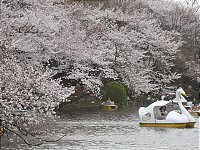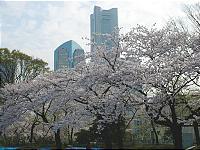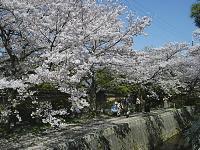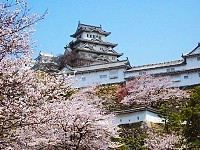Popular Hanami Spots
Below is an incomplete list of popular cherry blossom spots across the country:
| Tokyo: | |
 | Ueno Park A few steps from Ueno Station One of Japan's most crowded, noisy and popular cherry blossom spots, Ueno Park features more than 1000 trees along the street leading towards the National Museum and around Shinobazu Pond. There is no entrance fee. Food stands are available. |
 | Shinjuku Gyoen 5 minute walk from Shinjuku Station Shinjuku Gyoen is a large park featuring more than one thousand cherry trees of over a dozen varieties in Western and Japanese style gardens. There is an entrance fee of 200 Yen, and the park is only open between 9:00 and 16:30. |
 | Chidorigafuchi Subway Kudanshita Station Cherry trees decorate the moats of former Edo Castle around Kitanomaru. There is no admission fee. Rowing boats are available for rent. Many food stands, can be found at nearby Yasukuni Shrine, where another one thousand cherry trees are planted. |
 | Sumida Park A few steps from Asakusa Station The park stretches for a few hundred meters along both sides of Sumida River. There is no entrance fee. Food stands are available. Hanami can also be enjoyed from boats that cruise the river. |
 | Aoyama Cemetery 5 minute walk from Subway Nogizaka or Gaienmae Station The straight road leading through the cemetery is lined and covered by hundreds of cherry trees. There is no admission fee. A few food stands are available. |
 | Koishikawa Botanical Garden 5-10 minute walk from Subway Hakusan or Myogadani Station Koishikawa Botanical Garden is a spacious park with many cherry trees and a Japanese landscape garden. It is a great place to view various cherry tree varieties. The admission fee is 330 Yen. |
 | Inokashira Park South of Kichijoji Station There are a few hundreds of trees in this public city park with a pond. There is no admission fee. Boats can be rented. |
| Yokohama: | |
 | Kamonyama Park 10 minute walk from Sakuragicho Station Kamonyama Park is a small public city park close to Minato Mirai 21. There is no admission fee. |
 | Sankeien 10 minutes by bus from JR Negishi Station Sankeien is a beautiful Japanese landscape garden in southern Yokohama, exhibiting a number of historic buildings from across Japan. Admission costs 300 Yen. |
| Kamakura: | |
 | Dankazura 2 minute walk from Kamakura Station Dankazura is a more than one hundred meter long approach to Tsurugaoka Hachimangu Shrine, all covered by cherry trees. There is no admission fee. |
| Nagoya: | |
 | Nagoya Castle 5 minute walk from Subway Shiyakusho Station Many cherry trees are planted in the park that surrounds Nagoya Castle. The admission fee to the castle and the surrounding park is 500 Yen. |
| Kyoto: | |
 | Maruyama Park Next to Yasaka Shrine Maruyama Park is Kyoto's most popular public park for cherry blossom viewing. Its centerpiece is a large weeping cherry tree that gets lit up in the evenings. There is no admission fee. Many food stands are available. |
 | Philosopher's Trail Starting at Ginkakuji Temple The Philosopher's Trail is a pleasant path besides a canal that connects Ginkakuji (Silver Pavilion) with the vicinity of Nanzenji. It is lined by hundreds of cherry trees. |
 | Heian Shrine Behind the main building Large numbers of weeping cherry trees (shidarezakura) stand in the garden of Heian Shrine, behind the shrine's main buildings. Admission to the garden costs 600 Yen. |
 | Arashiyama Northwest of central Kyoto Arashiyama is a pleasant district in the outskirts of Kyoto. Many cherry trees can be found around the Togetsukyo Bridge at the foot of Arashiyama mountains. |
 | Kamogawa Kitaoji Station (Karasuma Subway Line) Kamogawa is the river, which runs through central Kyoto. Cherry trees are planted in many places along the river. One of the most pleasant places for cherry blossom viewing and a picnic is in northern Kyoto, where Kitaoji Street crosses the river. |
 | Daigoji Temple Daigoji Station (Tozai Subway Line) Daigoji is a temple complex in southeastern Kyoto, which is part of Kyoto's designated world heritage. A cherry blossom festival is held on the temple grounds every year. |
 | Hirano Shrine Between Kinkakuji and Kitano Hakubaicho One of Kyoto's most famous hanami spots, Hirano Shrine is also known for the many varieties of cherry trees found on its grounds. In the evenings, the trees are lit up. |
 | Okazaki Canal Outside Heian Shrine Located just outside of Heian Shrine, Okazaki Canal connects the Lake Biwa Canal network with Kamo River. It is lined by many cherry trees, and popular boat tours are conducted during the hanami season. |
| Osaka: | |
 | Osaka Castle Park Around Osaka Castle Large numbers of cherry trees can be found in the spacious public park around Osaka Castle. There is no entrance fee except for the Nishinomaru Garden. Food stands are available. |
 | Osaka Mint Bureau 10 minute walk from Temmabashi Station More than 300 cherry trees of over 100 cherry varieties, mostly later blooming yae-zakura trees can be viewed on the premises of the Osaka Mint Bureau during one week in April. |
| Yoshino: | |
 | Yoshinoyama Nara Prefecture Yoshinoyama (Mount Yoshino) has been Japan's most famous cherry blossom viewing spot for many centuries. The mountain is covered by approximately 30,000 cherry trees. |
| Himeji: | |
 | Himeji Castle 15-20 minute walk from Himeji Station The castle grounds of Himeji Castle are decorated by hundreds of cherry trees. Admission to the outer castle grounds is free. Entrance to the inner grounds and interior of the castle costs 600 Yen. |
| Tohoku: | |
 | Kakunodate Akita Prefecture The city of Kakunodate is famous for its weeping cherry trees, which decorate the city's well preserved, former samurai district. Another few hundred cherry trees stand along the nearby river. |
 | Hirosaki Castle Aomori Prefecture Over 2000 cherry trees are planted in the park surrounding Hirosaki Castle. Admission to the park is free. Food stands are available. Taken From ==<Click Here>== |
Labels: Hanami



0 Comments:
Post a Comment
Subscribe to Post Comments [Atom]
<< Home